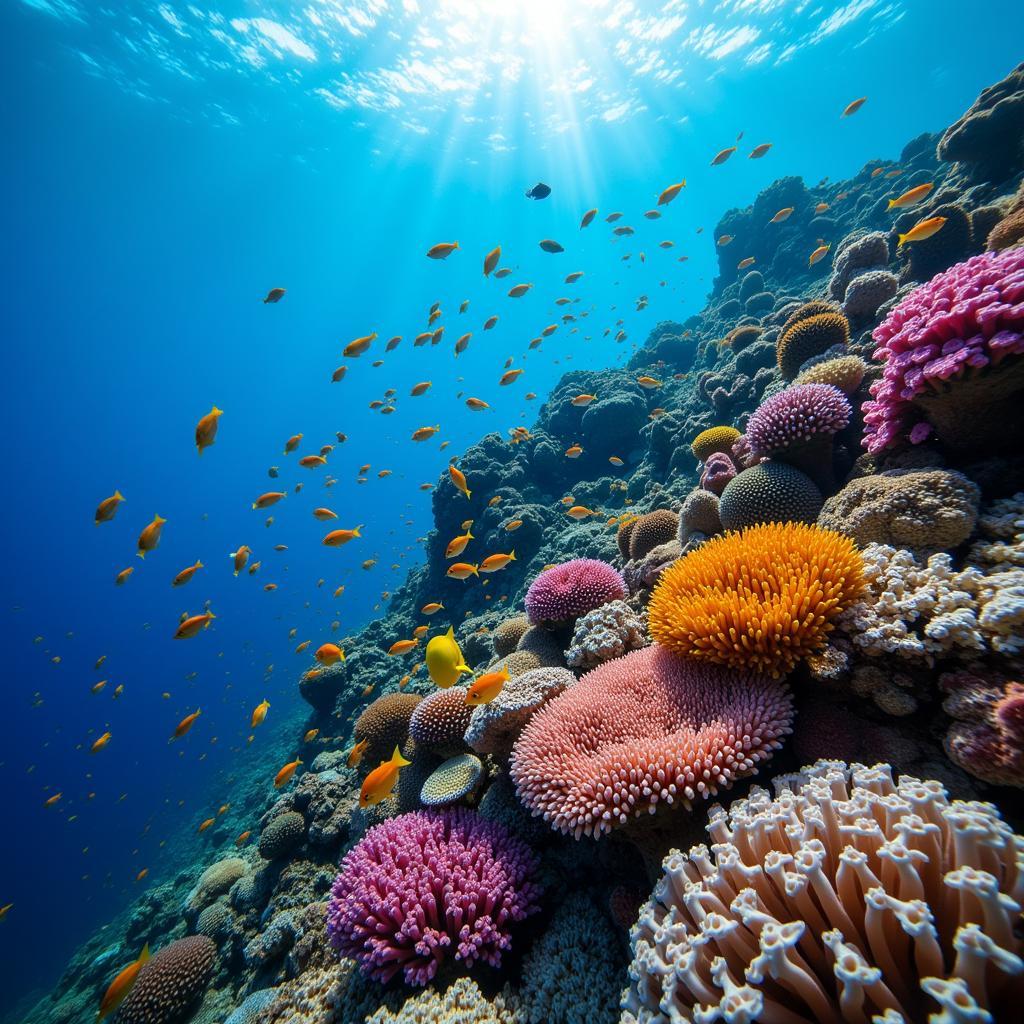The vast expanse of water covering our planet is a source of endless fascination. But have you ever wondered about the distinction between the terms “sea” and “ocean”? While often used interchangeably, these two bodies of water possess distinct characteristics that set them apart. Let’s dive into the depths of this intriguing “Sea Vs Ocean” debate.
Size and Depth: The Defining Factor
The most significant difference between a sea and an ocean lies in their size and depth. Oceans are massive bodies of saltwater that hold the majority of Earth’s water. They are significantly larger and deeper than seas, often reaching depths of thousands of meters. In contrast, seas are smaller, shallower bodies of saltwater that are typically partially enclosed by land.
Think of it this way: oceans are like giant bowls holding most of the world’s water, while seas are like smaller cups or plates partially filled from the larger bowls.
Connection and Location: How They Interact
Another key difference lies in their connection to landmasses. Oceans are vast and interconnected, flowing between continents. They are the primary bodies of water on Earth, with seas often found on the fringes of these larger oceans. Seas, on the other hand, are typically partially enclosed by land, connected to the open ocean through straits or channels.
 Seas and Oceans
Seas and Oceans
Marine Life: Diverse Ecosystems Thrive
Both seas and oceans teem with diverse marine life, but the types of organisms can vary based on factors like depth, salinity, and temperature. Oceans, due to their vastness and depth, support a wider array of species, from microscopic plankton to gigantic whales. Seas, often located closer to land, can also host unique ecosystems influenced by their proximity to coasts and freshwater sources.
For instance, the Mediterranean Sea, known for its warm temperatures and calm waters, supports a unique ecosystem with a high concentration of endemic species.
Salinity and Tides: The Influence of Land and Climate
While both contain saltwater, the salinity levels can differ between seas and oceans. Seas, due to their closer proximity to land, experience more freshwater inflow from rivers and rainfall, which can slightly dilute their salinity levels. Oceans, with their vastness, have more stable salinity levels.
Tides, the rhythmic rise and fall of sea levels, are also influenced by the connection between seas and oceans. Oceans experience larger, more pronounced tides due to the gravitational pull of the moon and sun. Seas, especially those more enclosed, may have smaller tidal ranges.
 Marine Life
Marine Life
Exploring the “Sea vs Ocean” Debate Further
To solidify our understanding, let’s address some common questions:
Is the Mediterranean Sea an Ocean?
Despite its size, the Mediterranean Sea is classified as a sea because it is almost entirely enclosed by land, connecting to the Atlantic Ocean through the narrow Strait of Gibraltar.
Are All Seas Smaller Than Oceans?
While generally true, there are exceptions. The Sargasso Sea, located within the North Atlantic Ocean, is larger than some seas yet classified as such due to its unique characteristics and lack of bordering landmasses.
Why is the Distinction Important?
Understanding the difference between seas and oceans is crucial for various fields, including marine biology, oceanography, and even geography. It helps us comprehend the complex interactions between these bodies of water, their impact on climate, and the diverse life they support.
Conclusion: A Deeper Appreciation for Our Blue Planet
The “sea vs ocean” debate highlights the intricate and awe-inspiring nature of our planet’s aquatic realms. While seemingly similar, these bodies of water possess distinct characteristics that influence their ecosystems, marine life, and even our climate. By understanding these differences, we gain a deeper appreciation for the delicate balance that sustains life in our oceans and seas.
FAQs
1. What is the largest ocean in the world?
The Pacific Ocean is the largest and deepest ocean on Earth.
2. What is the smallest sea in the world?
The Arctic Ocean is often considered the smallest of the world’s oceans.
3. What causes ocean currents?
Ocean currents are driven by a combination of factors, including wind, the Earth’s rotation (Coriolis effect), temperature differences, and salinity gradients.
4. How do oceans influence the climate?
Oceans play a crucial role in regulating Earth’s climate by absorbing and distributing heat around the globe through ocean currents.
5. What are some threats to the health of our oceans and seas?
Pollution, overfishing, and climate change pose significant threats to the health and biodiversity of our oceans and seas.
Need More Information?
For further inquiries or assistance, please don’t hesitate to contact us:
Phone: 02838172459
Email: [email protected]
Address: 596 Đ. Hậu Giang, P.12, Quận 6, Hồ Chí Minh 70000, Việt Nam
Our dedicated customer support team is available 24/7 to assist you.